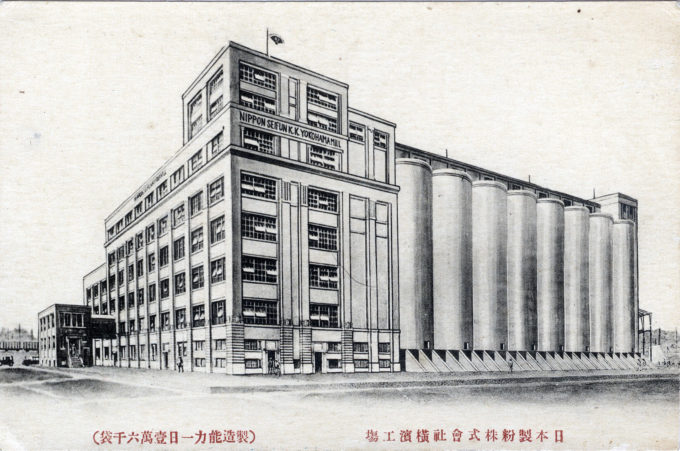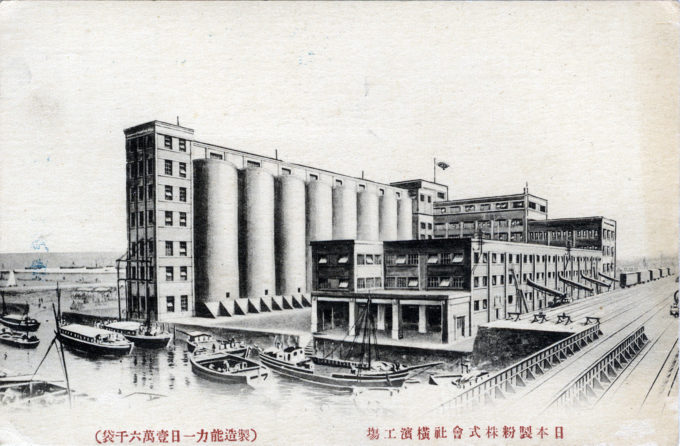“Japan first embarked upon the flour-milling industry in those years of Meiji during which she began to enter into closer communication with foreign countries with the establishment in 1873 of Sapporo Flour Mills in Hokkaido.
“It would later privatize and merge with Tokyo-based Nippon Seifun K.K. [Japan Flour Mills, Co.] in 1896 to establish the first modern mechanical flour milling company in Japan. [T]he industry went forward in a decidedly quickened pace with the Russo-Japanese War (1904-05) and the World War (1914-18) acting as incentives.
“The yield of flour for all Japan was only 300 barrels in 1905, which increased to 8,700 barrels in 1911, 20,000 barrels in 1913, 36,482 barrels in 1925, and 42,479 barrels in 1928.
“The opening of the Yokohama Mill in 1924 represented Japan’s first fully-fledged large-scale coastal milling operation.”
– “Present Day Japan”, The Asahi Shimbun English Supplement, 1929

Nippon Flour Milling Co., Yokohama, c. 1930. The company continues to operate today (with a name change in 2021) as Nippn Corporation.
See also:
Nippon Ford Assembly Plant, Yokohama, c. 1930.
Yokohama Port centennial parade, 1958.
“The history of flour in Japan is a story of adaptation and transformation, as wheat-based flour was not a traditional staple in the Japanese diet. Instead, rice and other grains like millet and barley were the primary sources of carbohydrates for centuries. However, the introduction of flour and wheat-based products had a significant impact on Japanese cuisine and food culture.
“Wheat was first introduced to Japan around the 8th century AD through cultural exchanges with China and Korea. Initially, it was primarily used for making noodles, ‘soba’, made from buckwheat and later with a mix of wheat flour. These early noodles were a luxury item enjoyed mainly by the aristocracy and monks.
“During the Kamakura period (12th to 14th centuries), Buddhism played a significant role in popularizing wheat-based products. Monks brought knowledge of bread-making and wheat cultivation, and they established monasteries where bread and other wheat-based foods were produced. The use of wheat became more widespread but remained limited to religious communities.
“In the 16th century, Portuguese traders and missionaries brought bread and wheat to Japan, further contributing to the spread of wheat consumption. Bread, known as ‘pan’ in Japanese, became more widely available, but it was still not a staple food for the general population.
“Wheat production increased during the Edo period, and the availability of wheat flour became more common. However, rice remained the primary staple food for most Japanese people, and wheat products were still considered a luxury.
“The Meiji Restoration in the late 19th century marked a period of significant change in Japan, including dietary habits. The government actively promoted Western-style diets and technologies, leading to increased consumption of wheat-based products like bread.
“After World War II, wheat imports and flour production in Japan increased dramatically due to economic development and increased contact with Western culture. The Japanese government encouraged the consumption of bread and pasta as a source of affordable, nutritious food.
“Today, wheat flour is an integral part of Japanese cuisine. It is used in various forms, such as for making bread, noodles (both udon and ramen), pastries, and cakes. Japan has also developed its unique styles of bread and pastries, including sweet and savory creations.”


